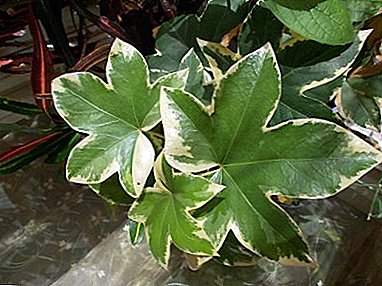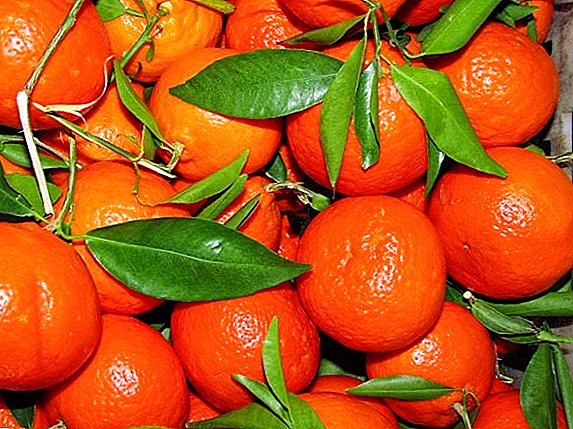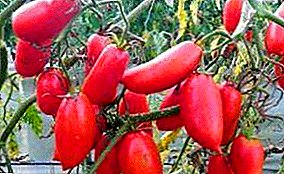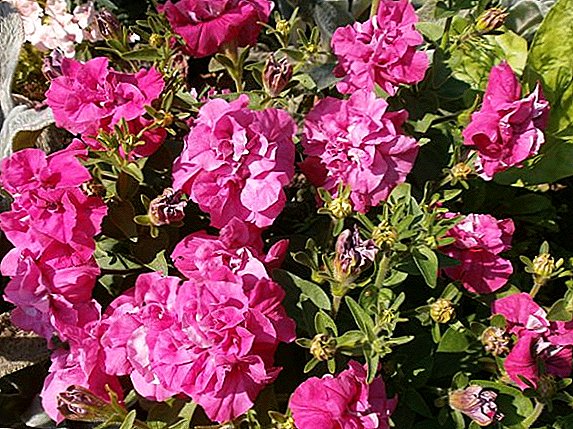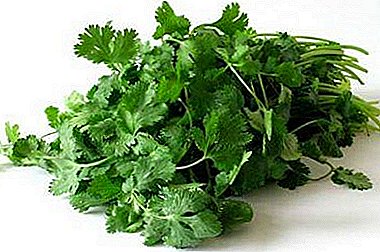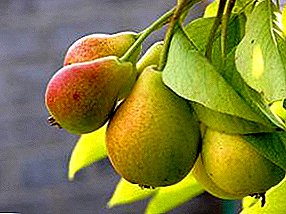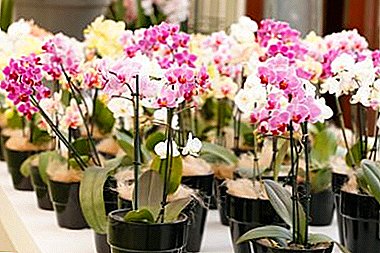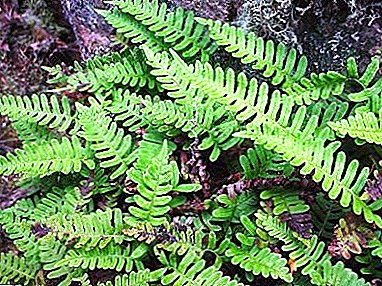
Polypodium or centipede, and in Latin Polypodium, belongs to the family of Millipede (Polypodia), along with Platicerium. The genus has about 200 species of ferns, common around the world.
Most of them live in the tropics and subtropics, and some species - in temperate latitudes.
Among the varieties of polypodium there are epiphytes growing in the crevices of rocks, on tree trunks and mossy rocks, and ground ferns that inhabit humid lowlands.
Description
 Depending on the growing area ferns species Polypodium are evergreen or deciduous.All varieties are characterized by a thick, creeping rhizome, covered with numerous scales.
Depending on the growing area ferns species Polypodium are evergreen or deciduous.All varieties are characterized by a thick, creeping rhizome, covered with numerous scales.
From it grow two rows of leathery carved leaves on long petioles, which, withering away, leave behind scab-like leaves.
For this feature the plant got its name - in translation it means "many legs".
Bright green fern is very diverse. Leaves or fronds can be whole, pinnate or double-circular shape.
On the lower part of the leaf plate are observed round-shaped growths of yellow-orange color - these are sporangia, forming spores. In the apartment polypodium sporonos extremely rarely. Some species of the centipede have recently been attributed by botanists to its closest relative, the genus Flebodium.
With proper care, polypodium lives in an apartment for many years, annually releasing several new leaves. It looks very impressive in the floor and hanging pot. This is a luxurious decoration of apartments, balconies, conservatories and home greenhouses.
Kinds
Golden
The most common type in indoor floriculture. Differs in beautiful feather-bladed fringes of bluish color, which gives them a wax coating that protects from dry air and pests. The length of the frond reaches 1 meter or more.
The rhizome is covered with numerous golden-brown hairs.
Photo subspecies Golden:
Multiple
Very spectacular and bizarre fern with large fronds that grow from the same rhizome, but different in shape. Each of them is original and one-of-a-kind. You can see the shape with solid, wavy, split or corrugated edges. Leaf sockets usually collect moisture, which helps to easily carry dry indoor air.
Photos of the Multi-fruited subspecies:
Virginia
A small-sized millipede with narrow feathery leaves is not more than 30 cm long and 6 cm wide. Each segment of the frond has slightly jagged edges.
Photos subspecies Virginsky:
Pimply
Very decorative variety. Differs pimply surface of dark green pinnately dissected leaves. In the dried state, they emit a subtle smell of coumarin.
Photo subspecies Pimply:
Austrian, cambric or southern
The view with the fronds of the deltoid pinworm-separate form, reaching half a meter in length. The leaf plate segments are lanceolate and serrate along the edge.
Photos of the Austrian subspecies:
West
A miniature variety with ascending wiami no more than 20 cm long. The narrow segments are entire, elliptical, or serrated. This is a frost-resistant fern, can withstand temperatures down to -29 ° C.
Photos subspecies Western:
Ussuri or linear
Epiphyte growing on tree trunks and in rock crevices. Dark green leaves of whole, linear-lanceolate form. Interestingly, in dry weather, they coagulate into a tube. Rhizome covered with brownish-black film. It is grown on stony hills and in rock gardens.
Photo subspecies Ussuri:
Californian
Deciduous fern with narrow oval leaves of pinnately dissected form. The segments are linear oblong and webbed. This representative flora is suitable for growing only in open ground.
Photo subspecies Californian:
Scooter
Spectacular beam-like fern with very wide glossy fronds of gray-green color. The shape of their feathery or pinnately dissected. Leaf plate feathers are also wide.
Photos of the subspecies of Scooler:
Serrated
Quite interesting large deltoids with long segments, serrated or serrated along the edges, which gives the plant openwork. The petioles are very long, almost equal to the length of the leaf.
Photos subspecies Pilchaty:
Ordinary
Only epiphytic fern growing in central Russia. This is a rare plant found on mossy rocks and rocky crevices. Its leaves are leathery and palmate-complex. The rhizome has a sweet taste, so the people call it the "sweet root". Very cold-resistant, withstanding temperatures down to -40 ° C.
Photo subspecies Ordinary:
Features home care
Polypodium considered the most picky of all the ferns. It feels great indoors and grows quickly, forming a lush bush of green feathery leaves. The correct mode of irrigation and high humidity - the main requirements that it imposes.
Lighting
Plant prefers light penumbra without the direct rays of the sun, leaving burns on it. The east, west and north sides are the optimal locations for its location.
Location on the southern window-sill will require shading with a light curtain. You can place a fern in the depths of a bright room or on a sunny plot, but under the cover of a larger plant.
Temperature
 In the spring and summer season polypodium like the usual room temperature.
In the spring and summer season polypodium like the usual room temperature.
In winter, he prefers temperatures from 14 to 20 ° C, and picky centipede pimply - from 12 to 14 ° C.
At that time It is important to protect the fern from drafts and hypothermia roots.
It is also very desirable to place it away from heating devices.
Watering and moisture
Water the plant should be moderate after the top layer of the earth gets dry. For this representative of the flora is equally harmful as the overdrying of earthy coma, and waterlogging, causing rotting of the roots. Water for irrigation should be taken soft and sufficiently settled.
Polypodium is in need of high humidity. is he loves daily spraying and periodic bathing in the shower. You can place the pot on a tray with wet pebbles so that the water level is below the bottom of the pot.
The centipede will gratefully reply to wiping leaves with a damp sponge. However, this procedure does not like the polypodium golden - its fronds are covered with a wax coating that may suffer.
Fertilizers (dressing)
Fertilize the plant should be very careful. From May to the end of August, 2 supplements with mineral complex per month are sufficient.
Fertilizer concentration should be 4 times weaker than indicated in the instructions. In winter, feeding is canceled.
Transplantation and soil composition
Repot polypodium spring or summer as it grows, when the rhizome fills the entire pot volume. Capacity required is wide and shallow. In addition, the green pet must be provided with good drainage.
When transplanting should not be too deep deepening rhizome - you just need slightly press in and slightly sprinkle it on top of the ground. Stretched shoots can be cut and used for breeding.
Soil should be loose and breathable with a weak acid reaction. You can prepare the substrate of the same parts of leaf humus, crushed pine bark and sphagnum. This composition is good for epiphytic ferns. And for all types of centipedes, a mixture prepared from 2 parts of leafy ground will be suitable, to which 1 part of coniferous earth, peat, humus and coarse sand is added.
Features care after purchase
 A polypodium that has got into the house from a flower shop should be carefully examined to make sure that there are no pests on it and to be placed separately from other flowers for a couple of days.
A polypodium that has got into the house from a flower shop should be carefully examined to make sure that there are no pests on it and to be placed separately from other flowers for a couple of days.
Then him need to transplant to a new container.
After all, as a rule, all plants are sold in a special transport substrate, which is unsuitable for permanent use.
After transplantation, place a new “green friend” in a light shade and provide it with all the necessary conditions. Fertilizer "newcomer" can be a month and a half, when it is fully adaptable.
Other indoor ferns include: Pelley, Pteris, Cirtriumium, Asplenium, Adiantum, Davallia, Blehnum, Salvinia, Nephrolepis, Platicerium, Uzzhnik and Humulus.
Breeding
Division
The rhizome of a healthy adult plant is cut into 2-3 parts so that each of them has several leaves. Sections are covered with wood ash. Delenki are planted in the substrate, covered with a plastic bag and put in a warm and shaded place for a week.
Disputes
This is enough laborious and complicated method. After the sporangia have turned brown, they are cut together with the sheet, placed in an breathable bag and suspended to dry.
After 7-8 days, spores will start to get enough sleep. For their germination using a mini greenhouse with underheating. A clean brick is placed in the tank, and on top of it is wet peat. Next, pour distilled water, filling the container at 5 cm.
Spores are scattered on the surface of peat, covered with plastic cover or glass and placed in a shady place. The amount of water in the container is always maintained at the same level. After several months, greenish moss will appear on the surface of the substrate, and then the first leaflets will appear. When the seedlings reach 5 cm in height, they dive into separate containers.
Diseases and pests
Polypodium enemies
 Shchitovka - brown bugs on the stems and leaves, sucking cell sap, why they brighten, dry out and die. Control measures: processing "Aktaroy" or "Aktellik".
Shchitovka - brown bugs on the stems and leaves, sucking cell sap, why they brighten, dry out and die. Control measures: processing "Aktaroy" or "Aktellik".
The spider mite leaves behind itself, as if pierced with needles, greens and spider webs. Control measures: pest removal soap sponge and insecticide treatment.
With excessive watering, the centipede is prone to root rot. If such a nuisance has occurred, remove the diseased roots, sprinkle the cuts with ashes and transplant the plant into a new ground.
Possible problems
The leaves turn yellow and die - an excess of moisture, low humidity in winter or too little light.
Dry leaf tips - insufficient moisture or irregular watering.
The leaves wither and become translucent - too much sun.
Wiii yellow with the formation of brownish spots - too hot in the room.
The leaves grow dull and the fern develops poorly - too small or too large a flowerpot, lack of nutrients.
Flippers turn brown, curl and fall off, fresh leaves fade - drafts, fever, watering with hard or cold water.
Beneficial features
The rhizome of polypodium ordinary ("sweet root") used for medicinal purposes. It contains essential oils, saponins, tannins, glucosides and malic acid.
In folk medicine, dried root is used in the form of infusions in the treatment of chronic cough, hoarseness, asthma, colds, as well as rheumatism, gout, and to get rid of constipation. In addition, the centipede root is used externally for bruises and sprains.
 Despite the fact that the polypodium requires a lot of attention and care, it can be maintained even by a beginning florist.
Despite the fact that the polypodium requires a lot of attention and care, it can be maintained even by a beginning florist.
It is only necessary to provide the centipede with proper conditions - and in return it will give the grower the beauty of her luxurious openwork leaves.


